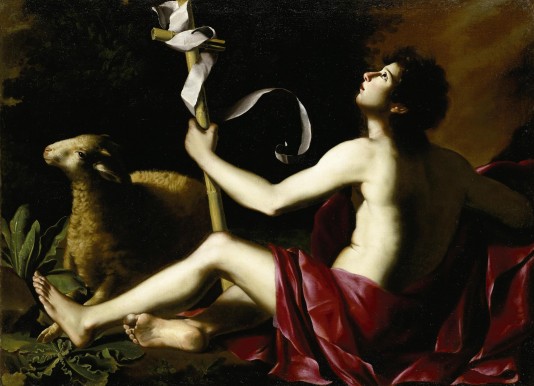Saint John the Baptist.
C. 1620-1630.
Oil on canvas, 39 3/8 x 53 ¾ in. (100 x 136.5 cm).
Literature: previously unpublished.
Starting in 2006, in two essays,[i] I began to trace the outline of an artist with an individual style whose oeuvre was largely contained within what may be considered the galaxy of paintings attributed to Tommaso Salini.
Indeed for some time I had felt an increasing sense of doubt as to whether this group of works could be regarded as uniform, since they would obviously clash with the few canvases securely identifiable as his; their language stands out markedly from any phase of the career of Salini, who – it is worth recalling – died relatively early, in 1625. During the Caravaggio e l’Europa exhibition of 2005 I pointed out the connection between a canvas requested for the section dedicated to attributional enigmas and anonymous masters (Il genio degli anonimi)[ii] – an Ecce Homo housed in the church of San Michele Arcangelo in Baranello – and the Four Crowned Saints in the Museo di Roma, a work exhibited with a somewhat risky attribution to Orazio Riminaldi,[iii] though its authorship had earlier been assigned to various artists, including Tommaso Salini; I had been among those who agreed with this in 1989.[iv]
In my subsequent writings of 2006 and 2009, the painting in Baranello thus became the name-piece around which I assembled a number of pictures that had belonged to the Salini group. In 2011, finally, I published a more extensive study of the subject, removing a number of figure paintings from the Roman painter’s precarious body of work – pictures that I believe clearly resemble one another, to the extent that they may be considered as by the same hand.[v] Apart from the two works mentioned above, this group includes the Amor Victorious in the Castle Gallery in Prague, the Allegory of Music in an unknown location, the Daedalus and Icarus in the Koelliker collection (each of these two paintings repeats the face of the male saint in the foreground of the small altarpiece now in the Museo di Roma), the Crowning with Thorns in the Pushkin Museum, Moscow, and the Old Woman with a Young Man Drinking from a Flask of Wine and the Mocking of Christ, both untraced; all these works were discussed in my publication of 2011.
In my opinion the work in question belongs to the same master, and represents a first-class addition to his oeuvre, given its pictorial quality and radiant condition, fully confirmed by X-radiography. Any doubts about such authorship may be set aside: suffice it to compare certain details, such as the long, slender feet – these truly being one of the artist’s distinctive features – with those in the Four Crowned Saints in Rome, or with those of the Amor Victorious in Prague and the Koelliker Daedalus and Icarus, and we find identical forms, not to mention the same way of shading the skin and toes. Another unmistakable element is the description of the changeant red fabric (which appears to have the consistency of silk) wrapped around the Baptist’s waist, which is entirely similar to the drapery of Christ in the Ecce Homo in Baranello (not red, but changeant, like the one before us), to that of the saint in the middle of the canvas in the Museo di Roma, to the Amor Victorious in Prague, but also to the Crowning with Thorns in the Pushkin Museum and the Saint Jerome in Palazzo Spinola in Genoa.
The present painting contains some especially admirable passages: the outward-turned foot, bearing traces of the ground the saint has trodden, and the subtly-rendered shadow of the other leg, cast across his ankle and calf; the beautiful cross, the convexity of its two rods painstakingly described; and the remarkable scroll (conservation has eliminated the inscription Ecce Agnus Dei, which turned out to be an addition), curling around it and fluttering, and described with refined sensitivity to its soft shadows and lights and its sinuous passage through space.
As I wrote in 2011, a series of stylistic clues point to the Master of Baranello’s Neapolitan origins, although it seems the painter must have had a Roman connection, too, given the echoes of Tommaso Salini in his work, and the presence of one of his own altarpieces in the Papal City – the Four Crowned Saints, once in San Tommaso dei Cenci.
Gianni PAPI
(translated from Italian)
[i] G. Papi, “Postille ai dipinti in mostra a ‘Il genio degli anonimi’”, in L. Spezzaferro, ed., Caravaggio e l’Europa. L’artista, la storia, la tecnica e la sua eredità (symposium papers, Milan, 3-4 February 2006, coordinated by M. Fratarcangeli), Cinisello Balsamo, 2009, pp. 224-229; id., “Un nuovo San Paolo di Valentin e alcune ‘anonime’ aggiunte”, in M. Calvesi and A. Zuccari, eds., Da Caravaggio ai Caravaggeschi, Rome, 2009, pp. 379-390.
